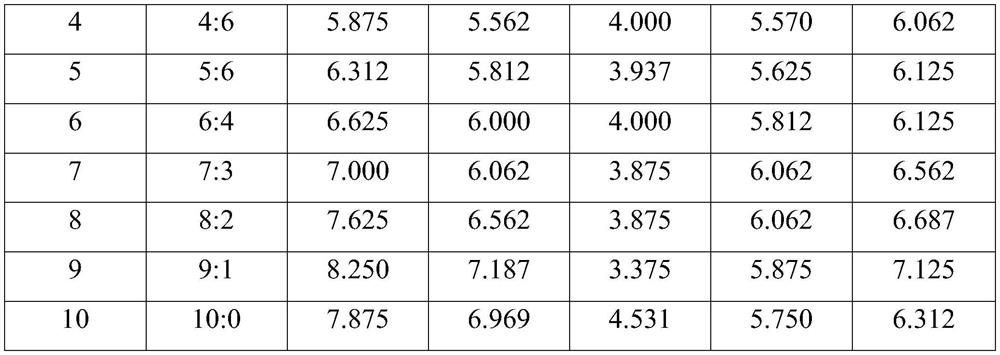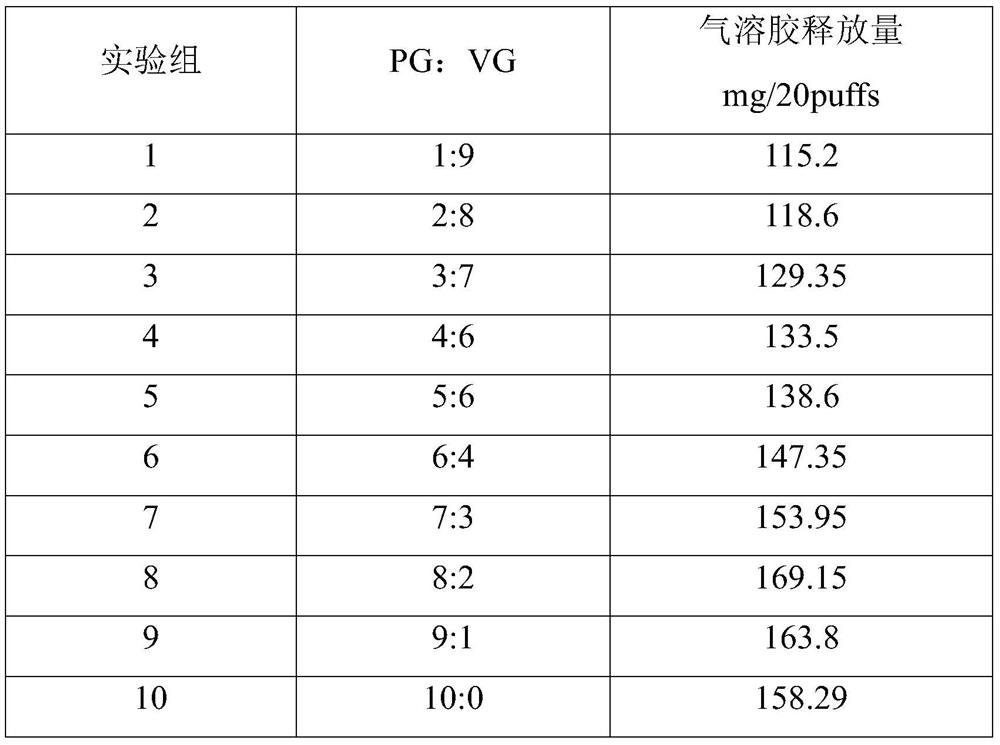Electronic cigarette tobacco tar
A technology of e-cigarettes and e-liquids, applied in the field of e-cigarettes, can solve problems such as excessive miscellaneous gas, reduced smoking pleasure, throat hit and head sensation, and irritating effects
- Summary
- Abstract
- Description
- Claims
- Application Information
AI Technical Summary
Problems solved by technology
Method used
Image
Examples
Embodiment 1
[0031] The components of the e-liquid in this embodiment include nicotine, propylene glycol and vegetable glycerin. Among them, the content of nicotine accounts for about 2% of the total mass of e-liquid. Further, nicotine is obtained by dissolving nicotine tartrate. In this embodiment, the experiment is divided into 10 groups according to the different addition ratios of propylene glycol and vegetable glycerin in the e-liquid. For example, the ratio of propylene glycol to vegetable glycerin in group 1 is 1:9, the ratio of propylene glycol to vegetable glycerin in group 2 is 2:8... and so on, the ratio of propylene glycol to vegetable glycerin in group 10 is 10:0, that is No added vegetable glycerin.
[0032] In this embodiment, the subjects (smokers and experts) were randomly divided into 10 groups, and the e-liquids of the above-mentioned experimental groups were tried to smoke, and the sensory evaluations of the subjects were recorded. Among them, the experimental result...
Embodiment 2
[0039] In Reference Example 1, the subjects had different sensory evaluations on e-liquids with different ratios of propylene glycol and vegetable glycerin. The components of the e-liquid in this embodiment include: different ratios of propylene glycol, vegetable glycerin, and 2% nicotine. The components of the e-liquid after atomization were analyzed and measured, and the experimental results shown in Table 2 were obtained.
[0040] In this embodiment, 10 experimental groups were divided with reference to Example 1, and the nicotine release amount was measured and recorded for the atomization treatment of e-liquid in each experimental group.
[0041] test group PG: VG Nicotine release (mg / 20puffs) 1 1:9 0.84 2 2:8 0.86 3 3:7 0.98 4 4:6 1.14 5 5:6 1.18 6 6:4 1.26 7 7:3 1.3 8 8:2 1.48 9 9:1 1.48 10 10:0 1.40
[0042] Table 2
[0043] As shown in Table 2, wherein PG is propylene glycol (propylene glyco...
Embodiment 3
[0046] In Reference Example 1, the subjects had different sensory evaluations on e-liquids with different ratios of propylene glycol and vegetable glycerin. The components of the atomized e-cigarette oil were analyzed and measured, and the experimental results shown in Table 3 were obtained.
[0047] In this embodiment, 10 experimental groups are divided with reference to Example 1, and the amount of aerosol released is measured and recorded for the atomization treatment of e-liquid in each experimental group.
[0048]
[0049] table 3
[0050] As shown in Table 3, wherein PG is propylene glycol (propylene glycol), and VG is vegetable glycerin (vegetableglycerin). The aerosol release amount is the cumulative amount of aerosol content in the smoke obtained when simulating 20 puffs of smoking. In the e-liquid of this embodiment, the mass of nicotine is about 2% of the total mass of the e-liquid. Among them, nicotine is obtained by dissolving pure nicotine or nicotine salt ...
PUM
| Property | Measurement | Unit |
|---|---|---|
| Viscosity | aaaaa | aaaaa |
| Viscosity | aaaaa | aaaaa |
Abstract
Description
Claims
Application Information
 Login to View More
Login to View More - R&D
- Intellectual Property
- Life Sciences
- Materials
- Tech Scout
- Unparalleled Data Quality
- Higher Quality Content
- 60% Fewer Hallucinations
Browse by: Latest US Patents, China's latest patents, Technical Efficacy Thesaurus, Application Domain, Technology Topic, Popular Technical Reports.
© 2025 PatSnap. All rights reserved.Legal|Privacy policy|Modern Slavery Act Transparency Statement|Sitemap|About US| Contact US: help@patsnap.com



